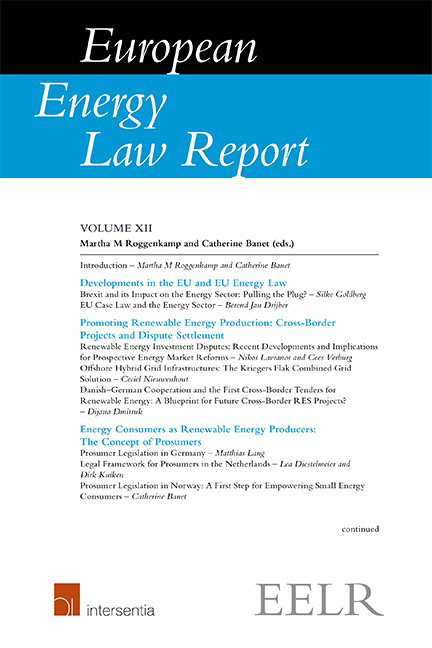Book contents
- Frontmatter
- Preface
- Contents
- List of Abbreviations
- List of Contributors
- Introduction
- PART I Developments In The EU and EU Energy Law
- PART II Promoting Renewable Energy Production: Cross-Border Projects And Dispute Settlement
- PART III Energy Consumers As Renewable Energy Producers: The Concept Of Prosumers
- Chapter VI Prosumer Legislation in Germany
- Chapter VII Legal Framework for Prosumers in the Netherlands
- Chapter VIII Prosumer Legislation in Norway: A First Step for Empowering Small Energy Consumers
- PART IV Balancing Renewable Electricity Production Withsupply Security: National Experiences With Capacity Mechanisms
- PART V Promoting The Use Of Sustainable Gas And Security Of Gas Supply
Chapter VII - Legal Framework for Prosumers in the Netherlands
from PART III - Energy Consumers As Renewable Energy Producers: The Concept Of Prosumers
Published online by Cambridge University Press: 31 January 2019
- Frontmatter
- Preface
- Contents
- List of Abbreviations
- List of Contributors
- Introduction
- PART I Developments In The EU and EU Energy Law
- PART II Promoting Renewable Energy Production: Cross-Border Projects And Dispute Settlement
- PART III Energy Consumers As Renewable Energy Producers: The Concept Of Prosumers
- Chapter VI Prosumer Legislation in Germany
- Chapter VII Legal Framework for Prosumers in the Netherlands
- Chapter VIII Prosumer Legislation in Norway: A First Step for Empowering Small Energy Consumers
- PART IV Balancing Renewable Electricity Production Withsupply Security: National Experiences With Capacity Mechanisms
- PART V Promoting The Use Of Sustainable Gas And Security Of Gas Supply
Summary
INTRODUCTION
Driven by the EU Renewables Directive obligation to achieve a 14 % share of renewable sources in gross final energy consumption in 2020, the Netherlands has introduced various legal provisions aiming at incentivising the generation of electricity based on renewable energy sources (RES). Those provisions mainly entail financial support measures which led, for example, to the implementation of large-scale on- and off shore wind turbines, but also to small-scale generation such as photovoltaic (PV) installations on residential houses. While the latter can be integrated by individual small consumers on their own premises (referred to as ‘behind the meter’, or in law ‘transfer point’), larger facilities (wind turbines or PV parks) can also be deployed in a collective effort of small consumers beyond their own premises. In this way, small consumers can engage in electricity generation and gain subsequent financial benefits. However, engaging in electricity generation does not necessarily enable small consumers to be self-sufficient. Even though they might generate the same amount they consume, usually the intermittent character of RES does not coincide with the main consumption periods. Storage facilities (eg batteries or electric vehicles) could capture excess electricity for later consumption, but so far storage is not deployed on a wide scale. Therefore, small consumers who start generating electricity (individually or collectively) remain dependent on electricity supply by a supply company. These small consumers who also produce electricity are often referred to as ‘prosumers’. While this term is not legally defined in the Netherlands, several legal provisions exist which incentivise consumers to engage in electricity generation (in the following, ‘prosumer legislation’). This chapter outlines the main legal provisions and reflects on whether these provisions are suitable for a future electricity sector with increasing numbers of ‘prosumers’.
In order to provide guidance and structure to the analysis of the legal framework of prosumers in the Netherlands, the chapter first analyses how prosumers are defined in the Netherlands (section 2). Legal provisions on prosumers in the Netherlands can be categorised as those which either incentivise individual consumers, mostly small consumers, or groups of consumers (communities) to produce RES.
- Type
- Chapter
- Information
- European Energy Law Report XII , pp. 151 - 168Publisher: IntersentiaPrint publication year: 2018

